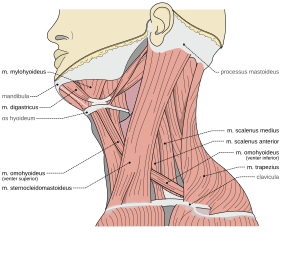Spasmodic torticollis
| Spasmodic torticollis | |
|---|---|
 |
|
| Muscles of the neck | |
| Classification and external resources | |
| Specialty | neurology |
| ICD-10 | G24.3 |
| ICD-9-CM | 333.83 |
| DiseasesDB | 13180 |
| eMedicine | emerg/597 orthoped/452 |
| MeSH | D014103 |
Spasmodic torticollis is an extremely painful chronic neurological movement disorder causing the neck to involuntarily turn to the left, right, upwards, and/or downwards. The condition is also referred to as "cervical dystonia". Both agonist and antagonist muscles contract simultaneously during dystonic movement. Causes of the disorder are predominantly idiopathic. A small number of patients develop the disorder as a result of another disorder or disease. Most patients first experience symptoms midlife. The most common treatment for spasmodic torticollis is the use of botulinum toxin type A.
Initial symptoms of spasmodic torticollis are usually mild. Some feel an invisible tremor of their head for a few months at onset. Then the head may turn, pull or tilt in jerky movements, or sustain a prolonged position involuntarily. Over time, the involuntary spasm of the neck muscles will increase in frequency and strength until it reaches a plateau. Symptoms can also worsen while the patient is walking or during periods of increased stress. Other symptoms include muscle hypertrophy, neck pain, dysarthria and tremor. Studies have shown that over 75% of patients report neck pain, and 33% to 40% experience tremor of the head.
Spasmodic torticollis is a form of focal dystonia, a disorder that is described by sustained muscle contractions causing repetitive and twisting movements, and abnormal postures in a single body region. There are two main ways to categorize spasmodic torticollis: age of onset, and cause. The disorder is categorized as early onset if the patient is diagnosed before the age of 27, and late onset thereafter. The causes are categorized as either primary (idiopathic) or secondary (symptomatic). Spasmodic torticollis can be further categorized by the direction and rotation of head movement.
Primary spasmodic torticollis is defined as having no other abnormality other than dystonic movement and occasional tremor in the neck. This type of spasmodic torticollis is usually inherited. Studies have shown that the DYT7 locus on chromosome 18p in a German family and the DYT13 locus on chromosome 1p36 in an Italian family is associated with spasmodic torticollis. The inheritance for both loci is autosomal dominant. These loci are all autosomal dominant inherited with reduced penetrance. Although these loci have been found, it is still not clear the extent of influence the loci has on spasmodic torticollis.
...
Wikipedia
